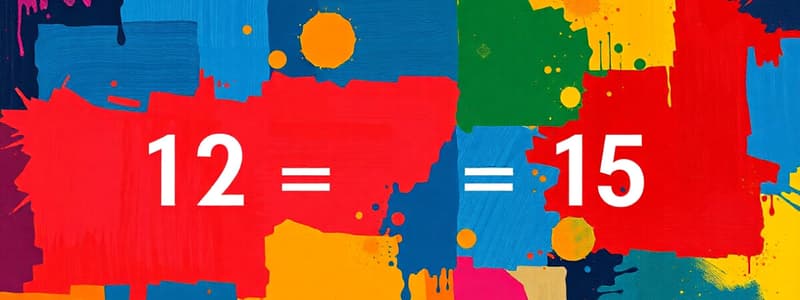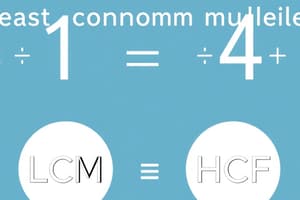Podcast
Questions and Answers
Considering Lane and Rory's performance, formulate a diophantine equation that models the times at which they strike and pluck together, and then solve for the smallest positive integer solution, explaining your reasoning.
Considering Lane and Rory's performance, formulate a diophantine equation that models the times at which they strike and pluck together, and then solve for the smallest positive integer solution, explaining your reasoning.
Let $9x = 15y$. The smallest solution occurs when $x=5$ and $y=3$. Therefore, they will next strike and pluck together after 45 seconds.
Propose an algorithm, using only Euclidean division and comparison, to determine the length of the ribbons David and Kylie can cut, proving that your algorithm always yields the greatest common divisor and relate this to Bezout's identity.
Propose an algorithm, using only Euclidean division and comparison, to determine the length of the ribbons David and Kylie can cut, proving that your algorithm always yields the greatest common divisor and relate this to Bezout's identity.
Use the Euclidean Algorithm to find the Greatest Common Divisor (GCD) of 180 and 225. $225 = 180 * 1 + 45$, $180 = 45 * 4 + 0$. Thus the GCD is 45. The longest length will be 45cm. Bezout's Identity states $ax + by = gcd(a,b)$
Given that $960 = 2^6 * 3 * 5$. Construct a formal proof, utilizing only the properties of prime factorization and divisibility, to demonstrate rigorously that 15 (3*5) is indeed the largest odd factor of 960.
Given that $960 = 2^6 * 3 * 5$. Construct a formal proof, utilizing only the properties of prime factorization and divisibility, to demonstrate rigorously that 15 (3*5) is indeed the largest odd factor of 960.
Since $960 = 2^6 * 3 * 5$, any odd factor must be a product of only 3 and 5. The largest such is $3 * 5 = 15$. Any larger odd factor would require another prime, contradicting the prime factorization.
Assuming the amounts collected from Mr. Rooly and Mrs. Ottick represent the exact total revenue from the trip, derive a formal argument, based on the properties of divisibility, to prove that the highest possible cost per pupil corresponds to the greatest common divisor of £255 and £136. What is this cost, and how many pupils are in each class?
Assuming the amounts collected from Mr. Rooly and Mrs. Ottick represent the exact total revenue from the trip, derive a formal argument, based on the properties of divisibility, to prove that the highest possible cost per pupil corresponds to the greatest common divisor of £255 and £136. What is this cost, and how many pupils are in each class?
Given HCF(a, b) = 32 and LCM(a, b) = 640, and knowing that $a * b = HCF(a, b) * LCM(a, b)$, determine all possible pairs (a, b) that satisfy these conditions. Further, derive a general formula for finding such pairs for any given HCF and LCM.
Given HCF(a, b) = 32 and LCM(a, b) = 640, and knowing that $a * b = HCF(a, b) * LCM(a, b)$, determine all possible pairs (a, b) that satisfy these conditions. Further, derive a general formula for finding such pairs for any given HCF and LCM.
Formulate a system of congruences that models Cain and Chas washing their bedding on the same day, and use the Chinese Remainder Theorem to find the next date they will both wash their bedding if they both wash their bedding on April 1st. Provide a detailed explanation of each step in the application of the Chinese Remainder Theorem.
Formulate a system of congruences that models Cain and Chas washing their bedding on the same day, and use the Chinese Remainder Theorem to find the next date they will both wash their bedding if they both wash their bedding on April 1st. Provide a detailed explanation of each step in the application of the Chinese Remainder Theorem.
Using the definition of a square number and the uniqueness of prime factorization, construct a formal argument to demonstrate that if a number's prime factorization contains only even exponents, the number is a square number. Then, apply this principle to show that 5625 is a square number.
Using the definition of a square number and the uniqueness of prime factorization, construct a formal argument to demonstrate that if a number's prime factorization contains only even exponents, the number is a square number. Then, apply this principle to show that 5625 is a square number.
Employ the properties of prime factorization and cube roots to derive a concise formula for determining the cube root of any number expressed as a product of prime factors with exponents divisible by 3. Apply this formula to show that $27000$ is a cube number, and explicitly calculate its cube root through prime factorization.
Employ the properties of prime factorization and cube roots to derive a concise formula for determining the cube root of any number expressed as a product of prime factors with exponents divisible by 3. Apply this formula to show that $27000$ is a cube number, and explicitly calculate its cube root through prime factorization.
Formulate a divisibility argument to determine all potential numbers of packets Sue-Lynn could have bought given that she has a total of 209 biscuits and each packet contains an equal number of biscuits. Justify why these are all the possibilities.
Formulate a divisibility argument to determine all potential numbers of packets Sue-Lynn could have bought given that she has a total of 209 biscuits and each packet contains an equal number of biscuits. Justify why these are all the possibilities.
Develop an algorithm based on prime factorization for finding the smallest number divisible by all integers from 1 to 10 inclusive. Then, rigorously prove that the number generated by your algorithm is indeed the smallest possible number satisfying this divisibility condition.
Develop an algorithm based on prime factorization for finding the smallest number divisible by all integers from 1 to 10 inclusive. Then, rigorously prove that the number generated by your algorithm is indeed the smallest possible number satisfying this divisibility condition.
Flashcards
Lowest Common Multiple (LCM)
Lowest Common Multiple (LCM)
The smallest number that two or more numbers all divide into evenly.
Highest Common Factor (HCF)
Highest Common Factor (HCF)
The largest number that divides evenly into two or more numbers.
Prime Factor Decomposition
Prime Factor Decomposition
Breaking down a number into its prime number building blocks.
Prime Number
Prime Number
Signup and view all the flashcards
Factor
Factor
Signup and view all the flashcards
Multiple
Multiple
Signup and view all the flashcards
Square Number
Square Number
Signup and view all the flashcards
Cube Number
Cube Number
Signup and view all the flashcards
Factorial (n!)
Factorial (n!)
Signup and view all the flashcards
Odd Factor
Odd Factor
Signup and view all the flashcards
Study Notes
- Problems involve prime factor decomposition and do not require a calculator.
Word Problems
- Lane strikes a drum every 9 seconds and Rory plucks a guitar every 15 seconds and both occur at the same time at the beginning.
- To find when they next strike and pluck together, determine the least common multiple of 9 and 15.
- David has 180cm of ribbon and Kylie has 225cm of ribbon. They want to cut the longest possible equal lengths without wasting any.
- To find the length of each piece, determine the highest common factor of 180 and 225.
- Express 960 as the product of prime factors and use the result to show that 15 is the largest odd factor of 960.
- Children are going to Blackpool; Mr. N Rooly collects £255 and Mrs. K Ottick collects £136.
- If the cost is a whole number, the highest possible cost requires finding the highest common factor of 255 and 136. The HCF will be the cost per pupil.
- The highest common factor of two numbers is 32 and the lowest common multiple is 640.
- To find what the two numbers could be, consider that the numbers must be multiples of 32 and factors of 640.
- Cain washes bedding every 4 weeks (28 days) and Chas washes bedding every 5 weeks (35 days).
- If they both wash bedding on April 1st, to find the next date both wash bedding, find the least common multiple of 28 and 35.
- Express 5625 as a product of prime factors to show that it is a square number.
- Use prime factorization to show that 27,000 is a cube number and find its cube root.
- Sue-Lynn has 209 biscuits and the biscuits are from packets that contain the same number of biscuits.
- To find how many packets she could have bought, you must factorize 209 and consider the possible number of biscuits per pack and thus the corresponding possible number of packets.
- Determine the smallest number that is divisible by 1, 2, 3, 4, 5, 6, 7, 8, 9, and 10.
- For any number m, m! is the product of all positive whole numbers from m down to 1.
- For example, 4! = 4 x 3 x 2 x 1.
- If n! = 2^8 x 3^4 x 5^2 x 7, to determine the value of n, consider the powers of each prime factor.
Studying That Suits You
Use AI to generate personalized quizzes and flashcards to suit your learning preferences.




